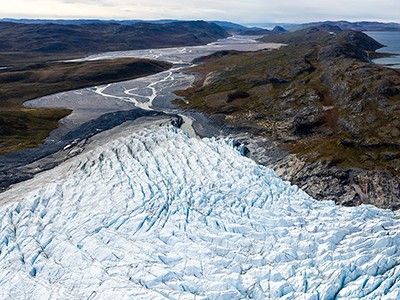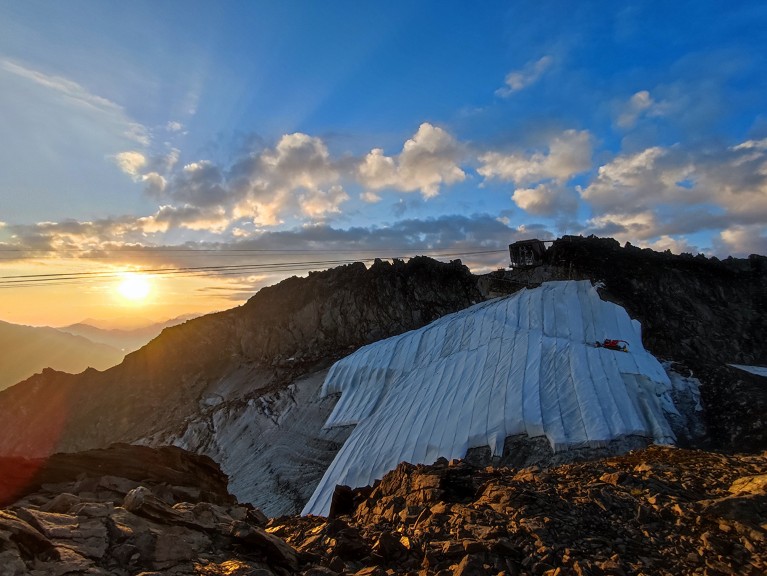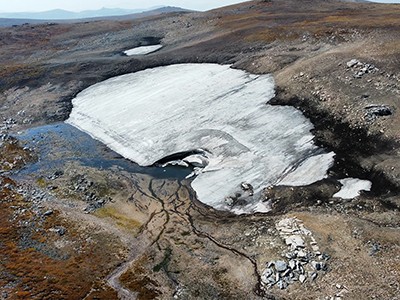Almost HALF half of the Earth’s half glaciers are likely to end up to 2100, even if the global temperature is met to a limited extent to 1.5 ° C.1. Already, Venezuela and Slovenia have lost all their glaciers – the first countries to do so in modern times.
The United Nations has declared 2025 as the International Year of Glaciers Protection, to draw attention to such disadvantages and highlight the significant part paid by glaciers, snow and snow in the climate system. Nevertheless, there is little consensus on ways to save the glacier.
Thirty years ago, when the UN framework convention on climate change was implemented, the answer was clear: reduce greenhouse gas emissions. Today, as carbon emissions are increasing, only reduction seems insufficient. Technical interference is being detected – including using small glass beads to reflect the snow, increase snowfall through cloud budding and wrap glaciers in safety films and geo textiles.2.

Greenland Icesheet is breaking faster than expected
However, the glaciers are much more than the frozen snow. Just like the oceans and rain forests, glaciers and ice sheets are mixed with life3As for, as.5. Glacial biomes are mainly comprised of microorganisms, and it only appears to the human eye during the colorful allocation. This microscope ecosystem includes members of all three life domains – archeia, bacteria and Ukraitis.
These germs are far from normal, which contains genes, which are molded in the summer between severe cold, short nutrients and severe sunlight in the darkness covered by winter snow. For example, Tibetan make antibiotics to some microorganisms found in glaciers so that they can eliminate microbes living in other ice.5. This genetic capacity has created an interest in bioplasting for antimicrobial and enzymes that can operate at low temperatures.6.
Glacier microbes have also been shown to collect and store heavy metals and other environmental pollution, which reduces the release of the flow of these pollution. The microbial communities of the glaciers can disrupt their efficacy as a contaminated buffer, the effects of knocking elsewhere in the environment.
Since speed prepares technical interference to slow, stop and even melt glaciers, we argue that they have to include the complexity of the icy biome that their purpose is to protect. Here, we outline the types of interference that are being seriously considered, how to evaluate their effects and the disciplinary guard rails that are urgently needed.
Snow melting speed
Local intervention to keep mountain glaciers safe in almost two types: aimed to maintain current snow and those who promote fresh ice formation2. So far, everyone has studied large, still poorly, on the glacier and the results of life within it. These techniques must begin a serious academic inquiry before adopting a wide range.
For example, researchers have experienced the effect of spreading silica-based glass-based hollow micro-spares and in 10-200 micrometer diameter, on the ice of an Arctic lake.7. The intervention increased the surface reflection and therefore delayed melting. However, blocking sunlight, in such ways, can damage the altogether and cinnobacteria contained in the ice.

In Switzerland, this small glacier reflectively helped Geo Textile help reduce melting.Credit: Matthews Haas
Another method is tested on Dago Glacier in China: Spread a thin film of cellulose acetate – artificial material made of cotton or wooden pulp8 – designed for the protection of frozen food initially on ice, this material scattered the coming sunlight and thus reduces melting8. However, the glacier over the scales of more than a few square meters, its ability to reduce mass damage, and its long -term stability and environmental effects have not been evaluated.
Wrap the glaciers in reflective geo textile (for example polypropylene) can reduce the snow every year by melting snow by 50-70 %.9. Such artificial blankets are already being used commercially – for example, to save artificial ice guruto of Rhine Glacier in Switzerland. Although the ice wrapped in a blanket like a material is slow to melt, it also prevents sunlight and nutrients.
In addition, polymer-based geo-textile microplastics releases in the environment-first in the snow and then in the flow environmental system. On an Austrian glacier, where geo -textiles have been used for nearly two decades, such microplastic fibers were recovered up to 3 km of ice. Small invertebrates eat these microplastics, which facilitates entering the food chain. Large fibers can also surround animals, which portray many problems associated with seawater waste.

Climate change reveals the secrets of our ancestors hidden in the snow
The point of view that aims to produce fresh ice is also downward. For example, in a small trial, researchers arranged snowfall from the clouds of Moz Touvo Glacier in the Savar Mountains, spread along the Kazakhstan and China border.10. However, it is difficult to estimate the performance of this interference because of the difficulties in targeting its use and reducing environmental costs.
It is also advised to pump water on the ice and use ice cannons. These interventions were tested on Murtasch Glacier in Switzerland11. Test results show that they work in principle. However, due to high cost, lack of water resources and a lack of detailed diagnosis of environmental impact, their real world was abandoned.
Technical interference on glaciers is reminiscent of large -scale climate geo -engineering suggestions, such as sprinkling particles in the upper environment and carbon arrest and storage. However, if the implementation is strong, icy interference is almost localized. Although there may be some issues from across the border, they usually have less moral and governance challenges, which make them more attractive to adapt to the initial impact of climate change.
Nevertheless, the environmental consequences of these interference have rarely received any attention from governments and policy makers. In addition, it is unclear how these strategies will affect communities, especially drinking water supply.

Glacier research can be difficult to access and access.Credit: Feature China/Future Publishing Via
Currently available interferences are also expensive and difficult to measure, which is why they are only suitable suitable for economically valuable places. Many glaciers are difficult to access. And the intervention needs to be repeatedly implemented or renewed. Researchers have estimated that if only all glaciers in Switzerland need to be evacuated, there is a tag of US $ 1.6 billion.12.
It is a matter of concern that many of the initial efforts to protect the glaciers are driven by commercial interests, which have more privileges to ignore environmental concerns.


